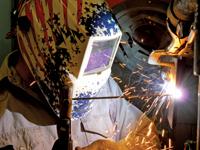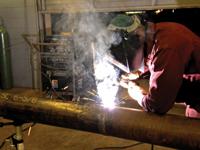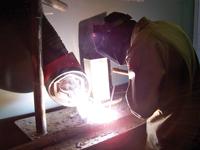- FMA
- The Fabricator
- FABTECH
- Canadian Metalworking
Categories
- Additive Manufacturing
- Aluminum Welding
- Arc Welding
- Assembly and Joining
- Automation and Robotics
- Bending and Forming
- Consumables
- Cutting and Weld Prep
- Electric Vehicles
- En Español
- Finishing
- Hydroforming
- Laser Cutting
- Laser Welding
- Machining
- Manufacturing Software
- Materials Handling
- Metals/Materials
- Oxyfuel Cutting
- Plasma Cutting
- Power Tools
- Punching and Other Holemaking
- Roll Forming
- Safety
- Sawing
- Shearing
- Shop Management
- Testing and Measuring
- Tube and Pipe Fabrication
- Tube and Pipe Production
- Waterjet Cutting
Industry Directory
Webcasts
Podcasts
FAB 40
Advertise
Subscribe
Account Login
Search
SMAW is in session
Reliability, portability key to process's lasting success
- By Amanda Carlson
- January 10, 2012
- Article
- Arc Welding

SMAW is tough to master, but the lessons students learn in the process end up being invaluable in their quest to become well-rounded welders. Photos courtesy of Jim Mosman, Odessa, Texas.
Amid the rapidly changing welding landscape is a process that, for the most part, has remained unchanged since Oscar Kjellberg invented the coated electrode. That’s right, shielded metal arc welding (SMAW), affectionately known as stick welding, has remained a simple yet effective method to join materials in a variety of applications and locations.
It’s not fancy or high-tech, yet it can be tricky and even downright frustrating to master. It doesn’t boast of aerodynamic welding guns or technologically advanced power sources, but it has played a major role in shaping our country’s infrastructure and skylines, and contributed to energy production as well as national defense.
Even though the technology behind SMAW has remained much the same for many years, it is still very much alive as companies rely upon its portability while veteran welders trust in its reliability. Because of this, it is important for welding educational programs to churn out welders capable of wielding a stinger and electrode.
While other processes like flux-cored arc welding (FCAW) are becoming more widely accepted in industries traditionally dominated by SMAW, welding educational facilities are finding that a need for skilled stick welders still exists. They also have found that valuable lessons are learned when students dive into the art of SMAW.
SMAW: Laying a Foundation
Mark Smith, full-time welding instructor at Shasta College, Redding, Calif., said one of the first processes his new welding students learn is SMAW. Smith has 19 years’ experience at the college and has found that having students start out with SMAW is, in the long run, easier on them.
“It’s much easier to teach someone how to stick weld first and then to wire weld. It seems to take longer to teach a person to stick weld and then to wire weld,” Smith said.
SMAW requires patience, dexterity, electrode manipulation, and puddle control. All are components of welding that play a part in laying an important foundation that students need as they continue their welding education.
The patience comes from trial and error during the first attempts at striking an arc, said Paul Leadingham, welding program coordinator at Illinois Valley Community College, Oglesby, Ill. IVCC has nine different SMAW classes that take welders from flat welding all the way to 6G pipe welding.
“One of the hardest parts of SMAW is striking the arc and getting it established and running. A lot of guys will stick the rod. One of the things I tell them is that they’re trying to strike the arc too hard. The lighter the better. The softer they go, the more control they’ll have, and eventually they’ll gain the confidence to go out and strike an arc whenever they need to.”
It can be a frustrating experience for some, which is why Jim Mosman, assistant professor of welding technology at Odessa College, Odessa, Texas, has his students spend a day or two practicing how to strike an arc, start a puddle, and break off the bead. And then there are those students who have a natural ability for the process.

Odessa College welding students who display a talent for SMAW are encouraged to enter the pipe welding program.
Odessa College’s welding program is experiencing growth thanks to a boom in the local oil and gas production industry. Mosman said the more than 100 welders enrolled in the program have a job waiting for them as soon as they develop basic welding skills. Drilling rig manufacturers are in need of welders for both indoor and outdoor production and assembly jobs.
In Mosman’s program, those who work hard to master the process as well as those who show natural ability are encouraged to enter the school’s pipeline welding program, where the curriculum is 100 percent dedicated to SMAW.
“There’s always a few that pick it up really quickly, and those are the ones that make me mad because I’ve had to work at it all my life,” Mosman added.
Leadingham said new welders, struggling or not, learn valuable skills from SMAW that come in handy in other processes such as gas metal arc welding (GMAW) and gas tungsten arc welding (GTAW), things like watching the puddle and maintaining an appropriate travel speed.
“Stick welding skills definitely transfer over. When you’re using GMAW you have to be able to hold different nozzle angles. Just like with SMAW there are a lot of different rod angles that you have to keep up with. Also, your travel speed is going to be very similar. We try to get them to study the puddle and keep it a consistent size, which is going to tell them how fast they need to move,” Leadingham explained.
Will FCAW Replace SMAW?
Technology improvements have encouraged flux-cored arc welding use in structural and heavy-equipment welding environments. One could argue that the productivity benefits from the semiautomatic process alone are worth the additional hassles associated with FCAW.
So that begs the question: Why doesn’t FCAW overtake SMAW?
The answer is quite simple. There are just some things that SMAW has that FCAW doesn’t.
The first is obvious. Despite efforts to make FCAW more portable, it still does not match the portability and simplicity of SMAW.
Leadingham said GMAW and FCAW dominate local industry, which comprises companies like John Deere, Caterpillar, and Vactor. But the program also accommodates the needs of local unions looking for ironworker and pipefitter apprentices, all of which are looking for skilled stick welders.
“The [FCAW] equipment is much heavier and bulkier to move around. You can have wire-feed problems because it’s tubular wire so it kinks easily. I look forward to seeing FCAW becoming more and more popular as time goes on, but I don’t see SMAW ever dying out.”
The second is trust. SMAW is a process that many manufacturing companies believe in for certain applications.
Smith recalls that when he first arrived at Shasta, FCAW was relatively unknown and definitely was not used within local industry.
“They weren’t educated on it and they didn’t grow up with it. It’s familiarity with what they’re doing. As we’ve expanded our program, they are beginning to believe in the reliability of FCAW a little more.”
Smith’s location also means he must train his students to weld according to the AWS D1.8 structural seismic code.
“There are seismic demands that the 7018 meet, and for FCAW it’s the E71T-8 rod. In some instances, those are the wires that are being used in the field. Because of the difficulty in running the E71T-8 wire, some companies opt to use the 7018 because it’s a little easier for their guys to run.”
In Texas’ Permian Basin, much of the welding activity revolves around energy, particularly the oil and gas industry. Whether it be for assembling or repairing drilling rigs out in the field, the trusted process is SMAW.
“There are companies that are trying to go to FCAW, but change is a slow process. Companies would have to rewrite their procedures, buy additional equipment, and retrain their welders. I see it happening slowly in the area, but I think SMAW will be strong at least for the foreseeable future,” Mosman said.
As in Odessa, Texas, much of the welding done in the area surrounding Redding, Calif., is SMAW. Shasta College is located in rural northern California, where equipment repair and lumber mills dominate the local industry. Like many welding programs do, Smith bases his curriculum on the feedback from his advisory committee, which is made up of companies that rely heavily on SMAW.
“A number of companies in our area still use only SMAW. Our millwrights that work in our lumber mills use it because they are going into small areas and doing small amounts of welds. A lot of our equipment repair people rely on SMAW. In some cases, the shops that make up our program’s advisory committee haven’t totally bought into wire welding, so they’ll use SMAW for the reliability and the portability.”
About the Author

Amanda Carlson
2135 Point Blvd
Elgin, IL 60123
815-227-8260
Amanda Carlson was named as the editor for The WELDER in January 2017. She is responsible for coordinating and writing or editing all of the magazine’s editorial content. Before joining The WELDER, Amanda was a news editor for two years, coordinating and editing all product and industry news items for several publications and thefabricator.com.
About the Publication
subscribe now

The Welder, formerly known as Practical Welding Today, is a showcase of the real people who make the products we use and work with every day. This magazine has served the welding community in North America well for more than 20 years.
start your free subscription- Stay connected from anywhere

Easily access valuable industry resources now with full access to the digital edition of The Fabricator.

Easily access valuable industry resources now with full access to the digital edition of The Welder.

Easily access valuable industry resources now with full access to the digital edition of The Tube and Pipe Journal.
- Podcasting
- Podcast:
- The Fabricator Podcast
- Published:
- 04/16/2024
- Running Time:
- 63:29
In this episode of The Fabricator Podcast, Caleb Chamberlain, co-founder and CEO of OSH Cut, discusses his company’s...
- Trending Articles
Sheffield Forgemasters makes global leap in welding technology

Welding student from Utah to represent the U.S. at WorldSkills 2024

Lincoln Electric announces executive appointments

Lincoln Electric acquires RedViking

Engine-driven welding machines include integrated air compressors

- Industry Events
16th Annual Safety Conference
- April 30 - May 1, 2024
- Elgin,
Pipe and Tube Conference
- May 21 - 22, 2024
- Omaha, NE
World-Class Roll Forming Workshop
- June 5 - 6, 2024
- Louisville, KY
Advanced Laser Application Workshop
- June 25 - 27, 2024
- Novi, MI




























